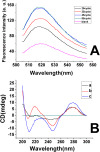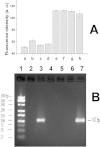Triplex DNA: A new platform for polymerase chain reaction-based biosensor
- PMID: 26268575
- PMCID: PMC4534768
- DOI: 10.1038/srep13010
Triplex DNA: A new platform for polymerase chain reaction-based biosensor
Abstract
Non-specific PCR amplification and DNA contamination usually accompany with PCR process, to overcome these problems, here we establish a sensor for thrombin by sequence-specific recognition of the PCR product with molecular beacon through triplex formation. Probe A and probe B were designed for the sensor, upon addition of thrombin, two probes hybridized to each other and the probe B was extended in the presence of Klenow Fragment polymerase and dNTPs. The PCR amplification occurred with further addition of Taq DNA Polymerase and two primers, the PCR product was recognized by molecular beacon through triplex formation. The fluorescence intensity increased with the logarithm of the concentration of thrombin over the range from 1.0 × 10(-12) M to 1.0 × 10(-7) M, with a detection limit of 261 fM. Moreover, the effect of DNA contamination and non - specific amplification could be ignored completely in the proposed strategy.
Figures





Similar articles
-
Homogenous assay for protein detection based on proximity DNA hybridization and isothermal circular strand displacement amplification reaction.Anal Bioanal Chem. 2017 Jun;409(16):4079-4085. doi: 10.1007/s00216-017-0356-0. Epub 2017 Apr 19. Anal Bioanal Chem. 2017. PMID: 28424856
-
A label-free light-up fluorescent sensing platform based upon hybridization chain reaction amplification and DNA triplex assembly.Talanta. 2018 Nov 1;189:137-142. doi: 10.1016/j.talanta.2018.06.051. Epub 2018 Jun 15. Talanta. 2018. PMID: 30086897
-
Electrochemical genosensor based on peptide nucleic acid-mediated PCR and asymmetric PCR techniques: Electrostatic interactions with a metal cation.Anal Chem. 2006 Apr 1;78(7):2182-9. doi: 10.1021/ac051526a. Anal Chem. 2006. PMID: 16579596
-
Molecular beacon DNA probes and their bioanalytical applications.Appl Spectrosc. 2004 Sep;58(9):269A-280A. doi: 10.1366/0003702041959406. Appl Spectrosc. 2004. PMID: 15479516 Review. No abstract available.
-
Molecular beacon: a multitask probe.J Appl Microbiol. 2005;99(3):435-42. doi: 10.1111/j.1365-2672.2005.02663.x. J Appl Microbiol. 2005. PMID: 16108784 Review. No abstract available.
Cited by
-
Sensitive Fluorescent Sensor for Recognition of HIV-1 dsDNA by Using Glucose Oxidase and Triplex DNA.J Anal Methods Chem. 2018 Apr 1;2018:8298365. doi: 10.1155/2018/8298365. eCollection 2018. J Anal Methods Chem. 2018. PMID: 29805840 Free PMC article.
-
pH-Responsive Triplex DNA Nanoswitches: Surface Plasmon Resonance Platform for Bladder Cancer-Associated microRNAs.ACS Nano. 2025 Feb 25;19(7):7140-7153. doi: 10.1021/acsnano.4c16396. Epub 2025 Feb 12. ACS Nano. 2025. PMID: 39939131 Free PMC article.
-
Switchable DNA tweezer and G-quadruplex nanostructures for ultrasensitive voltammetric determination of the K-ras gene fragment.Mikrochim Acta. 2019 Nov 25;186(12):843. doi: 10.1007/s00604-019-3993-5. Mikrochim Acta. 2019. PMID: 31768709
References
-
- Saiki R. K. et al. Enzymatic amplification of beta-globin genomic sequences and restriction site analysis for diagnosis of sickle cell anemia. Science 230, 1350–1354 (1985). - PubMed
-
- Sano T., Smith C. L. & Cantor C. R. Immuno-PCR: very sensitive antigen detection by means of specific antibody-DNA conjugates. Science 258, 120–122 (1992). - PubMed
-
- Malou N. & Raoult D. Immuno-PCR: a promising ultrasensitive diagnostic method to detect antigens and antibodies. Trends. Microbiol. 19, 295–302 (2011). - PubMed
-
- Zhang H. et al. Ultrasensitive assays for proteins. Analyst 132, 724–737 (2007). - PubMed
-
- Adler M., Wacker R. & Niemeyer C. M. Sensitivity by combination: immuno-PCR and related technologies. Analyst 133, 702–718 (2008). - PubMed
Publication types
MeSH terms
Substances
LinkOut - more resources
Full Text Sources
Other Literature Sources

